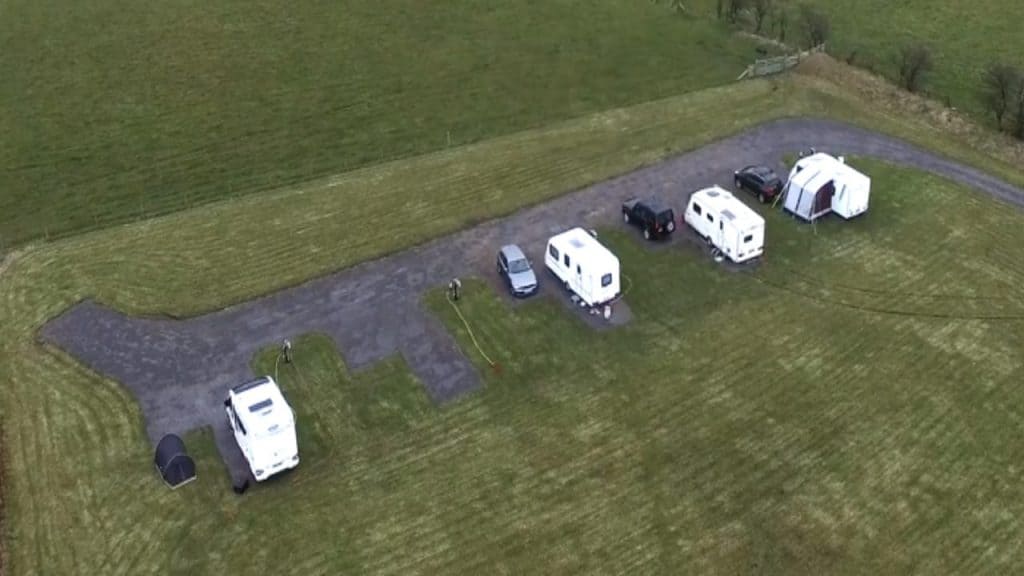
As you can see from the image above, at Horton Common, we have some amazing views over the Staffordshire Moorlands and Peak District National Park. However, it also means we have a higher average wind speed than most locations. That’s why even with our hard standing fully serviced pitches, I still close the site between the end of October and March. Therefore when it comes to our guests setting up their caravans and pitching their awnings, I get to see how effective the use of decent storm straps and quality pegs really are. So with this post, I thought I would provide some information on storm straps and caravan awning pegs currently available and which designs work best.
Disclaimer: Hey! By the way… any links on this page that lead to products on Amazon or Caravan Guard are affiliate links, and I earn a commission if you make a purchase, with no additional cost to you 🙂
- Dissolves waste and removes odours naturally and has delightful mild fragrance
Want To Visit Horton Common? – Book Here
Table of Contents
The Benefits Of Storm Straps
Storm straps are fitted to the outer corners of the awning to provide additional strength and wind resistance.
When awnings are most prone to the effects of wind is during gusts, potentially lifting the awning. Storm straps can help to provide tension and keep the awning in position and firmly secured to the ground.
Depending on the make and model of your awning, some come with storm straps included.
Many caravan awning manufacturers, while perhaps not included in the purchase offer their own version of a storm strap.
For instance, the video below is from Isabella awnings and their version of the storm strap called Stormband.
One of the benefits of the Isabella Stormband is that it does not connect to the fabric of the caravan awning, potentially causing damage under wind gusts.
The Isabella Stormband wraps around the corner poll connection. It also provides quite a neat solution fixed directly below the corner polls.
Hence not creating a tripping hazard with long diagonal storm straps.
Storm Strap Colours
With most storm staps they are fixed 1m to 2m into the ground diagonally from the furthest corners of the awning. Therefore, like any guy ropes, storm straps can potentially be a tripping hazard.
Therefore you want to purchase storm straps which are a bright fluorescent colour of either green or orange. That way you’re far less likely to trip over them.

Try to choose caravan awning storm straps of bright fluorescent colours to avoid them being a tripping hazard: Image – Amazon.co.uk
Metal Rachets Are Better Than Plastic Clips
On some storm straps, they use a quick-release plastic clip system.
The problem is with the many different kits you can purchase, the quality of plastic differs considerably. You also don’t know if the plastic clips are strong enough until they snap in a storm.
Most storm strap kits available online use quick release plastic clips, so they are hard to avoid. However, if you have the option, try to use a storm strap kit with ratchets.
You can then tension up the straps to provide the best wind resistance. Obviously, you’ll have to pay more for metal ratchets over plastic clips.
However, if the difference is your caravan awning staying against the ground, the price difference is insignificant.

When possible try and purchase caravan awning storm straps with metal ratchets instead of plastic clips: Image – Amazon.co.uk
Storm Strap Springs
When you install the caravan awning storm straps you want them to be tight but at the same time not bend any awning poles!
So it can be tricky getting the tension on the straps right to provide the best wind protection while allowing the awning to move a little.
Furthermore, as stated above, it’s under gusts of wind that most damage is caused.
This is where the springs on caravan awning storm straps play an important role. Under gusts of wind, they allow the awning to move slightly.
However, they are always working to keep the storm straps under tension. Now, obviously, as with the discussion on plastic clips above, different springs are made to different qualities.
You are far less likely to have a metal spring break on you than a plastic clip.

Springs help to keep the storm straps under tension while providing a bit of flexibility to the awning: Image – Amazon.co.uk
Avoid Using Caravan Awning Ladders With Storm Straps
Awning ladders are commonly attached between the side fixings of the awning when pegging down. The different holes on the ladders make it easier to peg down the awning on uneven ground.
They are made from synthetic rubber, which provides a bit of stretch and flexibility. However, they do snap.
Therefore don’t be tempted to use awning ladders instead of springs on storm straps, you’ll regret it.

Caravan awning ladders have their use when pegging down the sides of the awning. However, don’t be tempted to use them instead of metal springs or the storm straps, they are likely to snap: Image – Amazon.co.uk
Caravan Awning Pegs
So the storm straps you choose for your awning are only as good as the pegs you use to hold them into position. Therefore I thought I would highlight some of the pros and cons of different awning pegs.
You Need To Consider Changing Ground Conditions
Now, the type of awning pegs you can use will depend on the ground conditions. For instance, at Horton Common, we have hard standing pitches. However, the area provided for awnings is on grass.
Depending on the time of year though, some guests move their caravans forward to pitch the awning on the hardstanding.
So for instance at the start and end of the camping season when the grassed areas may be too soft.

Therefore it’s best to have a selection of awning pegs for both soft and hard ground. What is also important to remember is that grassed areas can be both hard and soft.
During a very hot summer, our field is like concrete. When the field is like that, it’s very easy to break plastic awning pegs.
Hard Ground/Rock Awning Pegs
Hard ground awning pegs are metal, often with a plastic clip at the top to connect to your guy ropes, awning ladders or storm straps.
There are lots of metal awning pegs you can purchase, however not all metal pegs are hard ground pegs.
You want to purchase metal pegs that are thick enough that they will not bend under a vigorous smack from the mallet.

If you are going to be setting up your awning on a hard standing pitch or a grass pitch in the middle of summer you need hard ground pegs: Image – Amazon.co.uk
You may be thinking, why would you ever use anything other than a hard ground peg? If they can go through the hard ground they will obviously go into soft ground.
The problem is in the wet soft ground these pegs have a relatively low surface area.
Furthermore, the benefit of being smooth when going into the hard ground is a downside when fixing into soft ground. Therefore in the soft wet ground, these types of pegs can easily be pulled out.
V-Shaped Metal Awning Pegs
For a middle ground between the best soft ground pegs and proper hard ground pegs, there are metal v-shaped pegs. These pegs have a greater surface area than proper hard ground pegs.
Therefore they perform better in soft ground. You can also sometimes use them on hard ground.
They are going to perform better than plastic pegs which snap, or thin metal pegs which will easily bend. However, if the ground is really hard, metal v-shaped awning pegs will also possibly bend.
As stated above, they are not the ‘best of both worlds’. However, they can serve as a good alternative to true soft/hard ground pegs.

V-shaped awning pegs will perform better than true hard ground pegs in soft ground. However, in hard ground, they can still sometimes bend: Image – Amazon.co.uk
Soft Ground Twist/Screw Peg Anchors
To provide the best wind resistance to an awning, you want to use pegs that grip the ground with the most surface area.
Therefore the best pegs to hold down your awning are twist anchor pegs. You may even see these types of twist/screw pegs as dog-lead anchors.
There are many different types on the market of various different lengths and sizes. The longer the twin anchor peg, the greater the grip surface area.
However, you also want to look at how wide the twist pegs are. Some of the pegs are solid with a screw on the outer surface. Other pegs are more open with wider screw surface area.
You may be thinking, as these pegs provide the best surface area, when not use screw-type pegs all the time?
Well, the reason is, if the ground is too hard, you may not be able to get a twist/screw peg into the ground. Some have a handle design so you can get a really good grip to rotate them into the ground.
You could even put a bar through the head of the screw pegs to provide better leverage. However, again you need to be careful not to put too much force on the peg to bend or snap it.

Screw peg anchors provide a lot surface area in the ground and are therefore one of the best soft ground anchors. However, you are unlikely to be able to get a screw peg like this into hard ground: Image – Amazon.co.uk
Conclusions On Awning Storm Straps & Pegs
So in summary, when it comes to awning storm straps you want to choose a brightly coloured material to avoid them being a tripping hazard. You also want to avoid plastic clips in favour of metal ratchets.
Finally, you want to use metal tensioning springs and avoid the use of rubber awning ladders. When it comes to pegs to hold down the storm straps, there is no ideal peg for every scenario.
You need an assortment of awning pegs to deal with the various hard and soft ground conditions you will experience.
Quick note, if you are considering a wind-out motorhome awning, the best option may still be to retract it if the wind picks up instead of relying on pegs and storm straps.
Well, I hope the above post has been useful, and I hope you consider coming to visit us at Horton Common at some point in the future. 🙂
Want To Visit Horton Common? – Book Here


